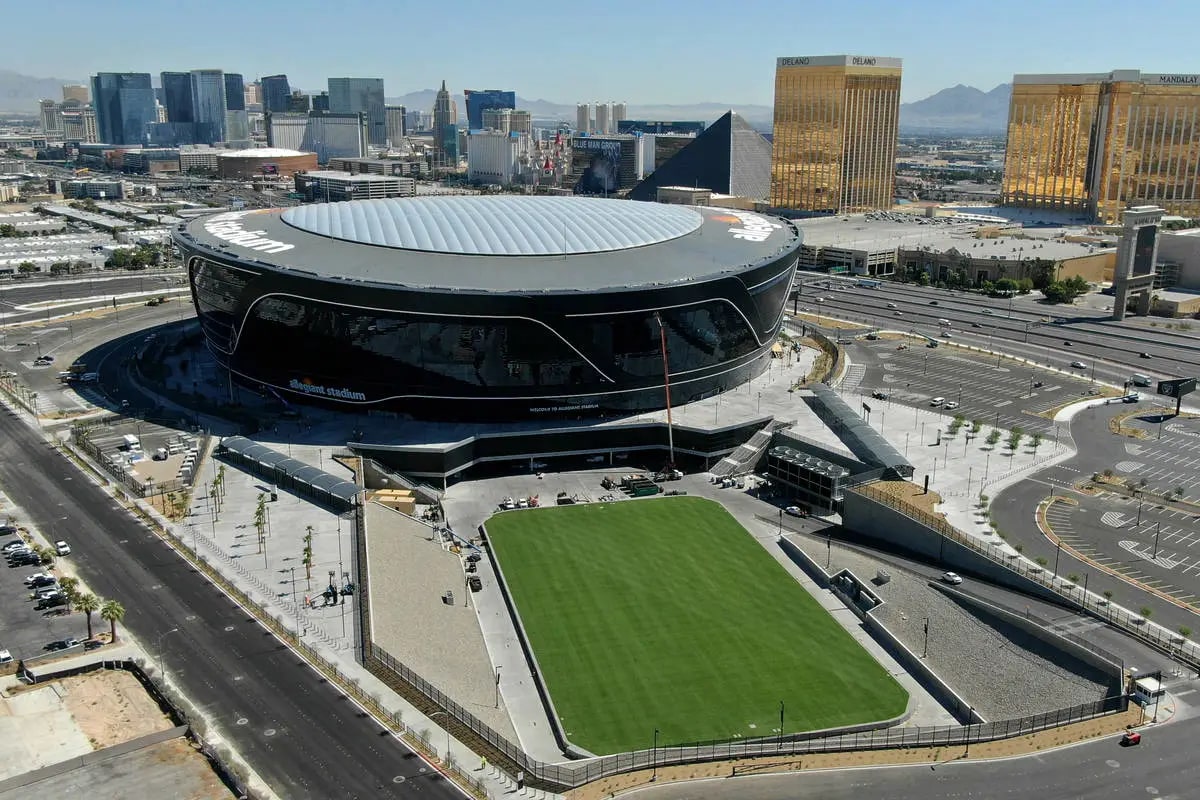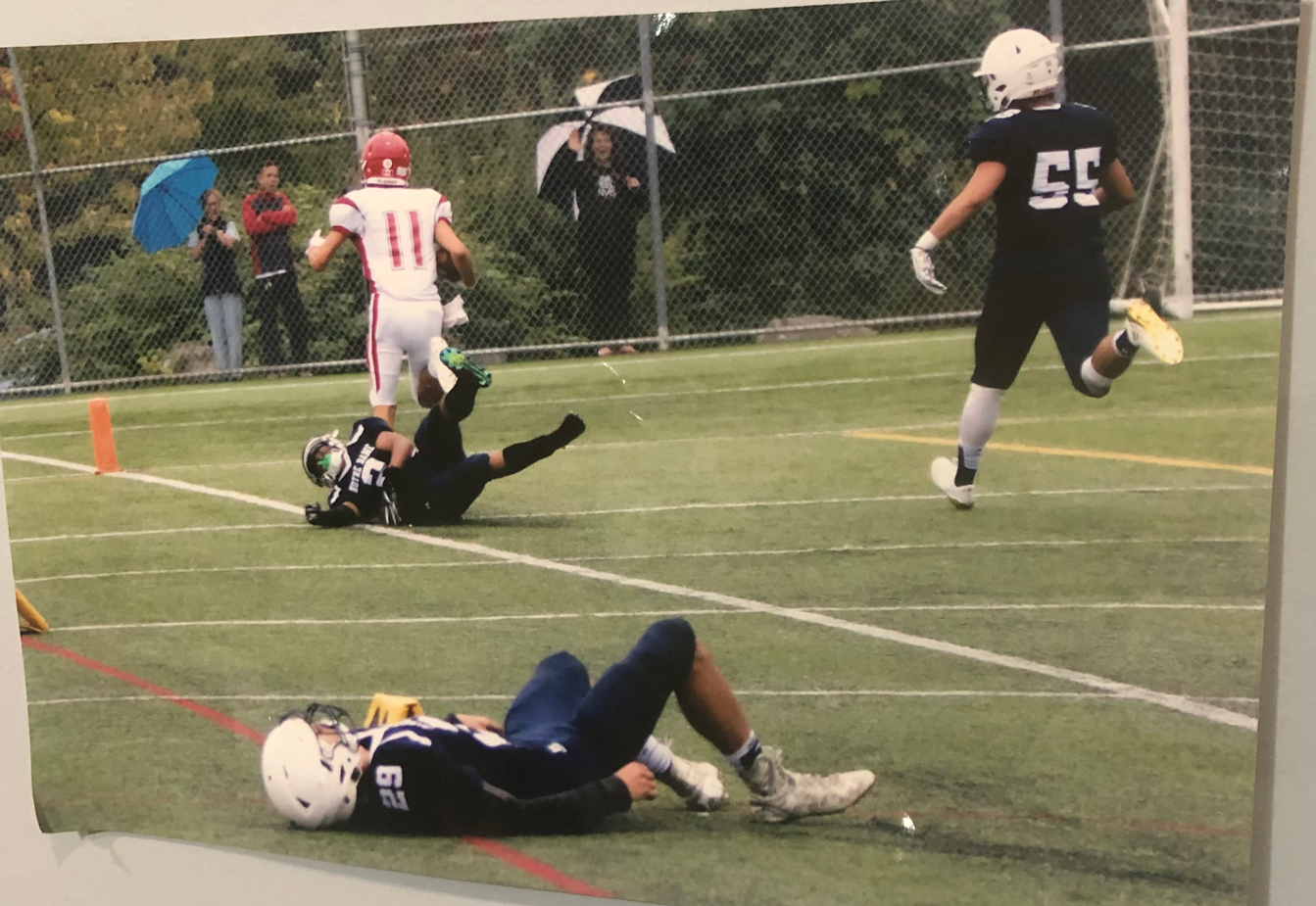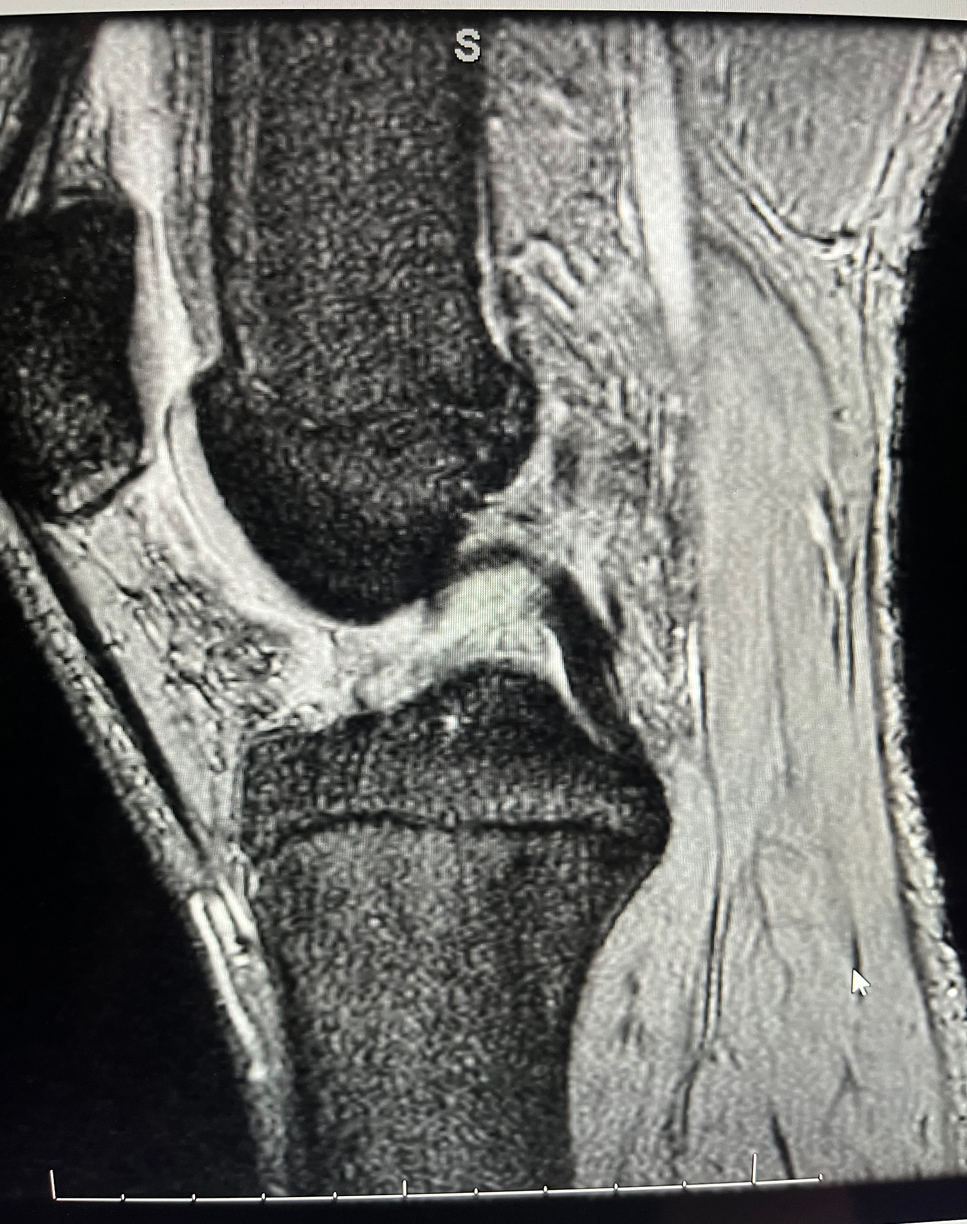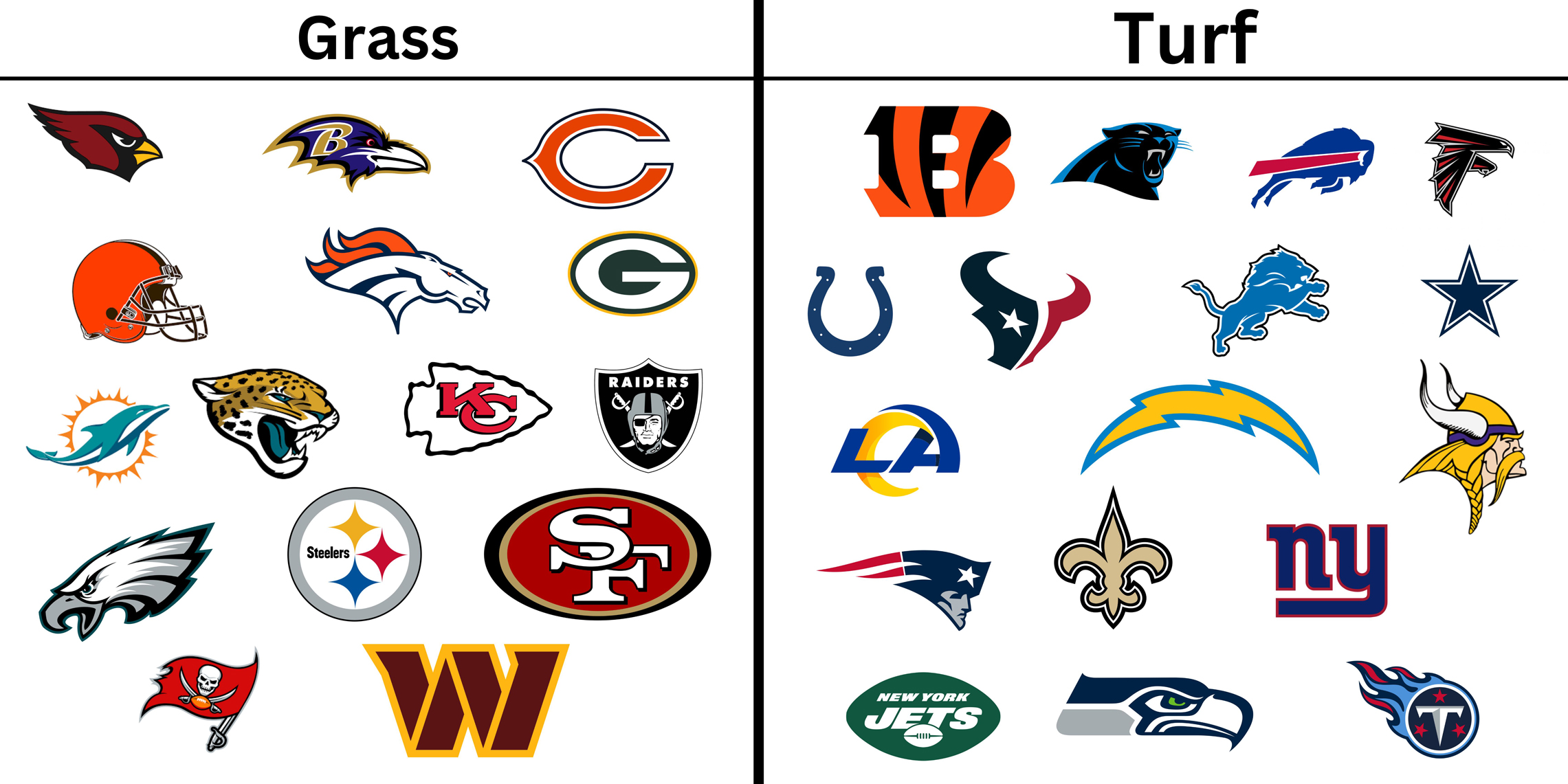
Vasco Repole
Vasco Repole is a fall 2023 Bachelor of Business Administration Degree program graduate with a marketing major from Capilano University. He has multiple appearances on the Dean’s List due to his high academic standing. He also has a background in athletics, having served as the captain of his football team. Vasco also likes to partake in many physical challenges such as Ironman triathlons and marathons. He has experience collaborating with underprivileged youth and has also worked on training high-end athletes across various sports. He is passionate about videography and hopes to channel this interest in his future endeavours.
What if there were a better solution to prevent career-altering injuries in the NFL? There are teams still using synthetic turf even with an increase in injuries, but at what cost? This issue can be very harmful to the careers of these athletes, the movement to push grass fields needs to happen now. Why hasn’t this change been made? Are the physical health and wellness of athletes affected by finances? Or do the people and organizations not know the danger that underlies these turf fields?
The National Football League Players Association (NFLPA) sent a request in 2020 to remove all synthetic turf fields from the NFL. Of course, it’s not the players who can make the decisions for the organization, but when they are the ones risking their bodies for the team, they should have a say. Players have a 28% higher rate of non-contact lower extremity injuries when playing on artificial turf, therefore, the cost of losing players to injuries completely outweighs the cost to shift into grass fields across the league (Tretter, 2023). Furthermore, these injuries not only take a toll on players physically but also exert a profound psychological impact. All NFL stadiums should transition from synthetic turf fields to grass fields immediately.
The NFL first introduced synthetic turf into its play in 1966, as the Houston Oilers were the first team to install this grass alternative named “Astroturf”. Houston’s Stadium (The Houston Astrodome), had problems with its natural grass growth, therefore, they searched for an easier alternative for this problem. Ever since the first NFL game in 1920, games were strictly played on grass fields. This shift was the beginning of one of the biggest changes in NFL history, as more teams started to implement it as well. There were many reasons for this change to “AstroTurf” by the organizations in the NFL, some of which included cost, maintenance, and even player performance. This turf could withstand high traffic which provided players with a consistent surface for long periods. As more teams started to follow, about half the NFL was using the synthetic turf “AstroTurf” by the 1990s. The stigma around this turf at the time was mostly positive since most teams made the switch from grass, but the downsides that came from it were considered costly. The “AstroTurf” had such a hard surface underneath that it caused a great rise in injuries around the NFL at the time (NFL 100, 2013). Teams had recognized the increase in the risk of injury with “Astroturf” and therefore searched for a softer and safer alternative. In 2002, a new and improved version of synthetic turf called “FieldTurf” was created and implemented into the first NFL stadium at Lumen Field, home of the Seattle Seahawks. In 2023, “FieldTurf” was the leading type of synthetic turf, alongside many other synthetic alternatives that include Hellas Matrix Turf, A-Turf Titan, UBU Speed Series S5-M, and Shaw Sports Momentum Pro.
Moreover, the current context surrounding the use of synthetic turf in the NFL keeps getting worse every year, but few changes have been made. In the 2023/2024 season alone, there have been many major injuries that have come from these artificial turfs. Aaron Rodgers, Kirk Cousins, Tre’Davious White, Jaelan Phillips, and Cam Akers are a few major NFL athletes who have torn their Achilles this season, all of which came from artificial turf. The combined 2023/2024 yearly salary of these players reached roughly $77.6 million, that’s how much has been wasted by their respective teams due to the season-ending injuries sustained on turf. The National Football League Players Association (NFLPA) sent out an official statement to the NFL on September 13, 2023, regarding the shift for all stadiums to move into natural grass fields. NFLPA Executive Director Lloyd Howell stated that this issue is at the top of players’ list when asked about any improvements the NFL can make (CBS, 2023). Many players in the NFL are pro-grass and have been for a long time, in 2008, 72% of players said they preferred playing on natural grass over artificial turf whereas the opposite only favored 11% of players asked. Players are also showing their concern in the media as well, when former Super Bowl MVP and regular season MVP Patrick Mahomes said “The numbers say that grass is healthier for the players, and I want to play on the surface that keeps me healthy”(Sun, 2023). Other players such as Super Bowl Winner Von Miller blames turf for the ACL injury that has him on the physically unable-to-perform list to start this season (Sun). The NFL players also realize why the NFL isn’t changing even with all this drama surrounding the issue. Green Bay Packers left tackle David Bakhtiari stated “Owners can wait to demand something in return during the next contract negotiations, and artificial surfaces help them make money hosting other events” (Walker, 2023). This issue is just gaining more attention over time after people see more players constantly get injured on turf, this is something that will linger on forever until the NFL decides to do what’s right for the players and not itself.

Las Vegas Raiders “Allegiant Stadium” removable natural grass field for their dome stadium. They are one of the few teams in the NFL that use natural grass in a dome stadium.
In 2023, fifteen NFL teams are still using synthetic turf surfaces even when studies have shown an increase in injuries among players. There can be many reasons why organizations aren’t making the change. Firstly, is the maintenance needed to obtain a grass field, especially during a long and aggressive weather-inducing football game, teams may opt for turf in the scenario where something goes wrong mid-game with a grass field. Additionally, the maintenance of grass fields over the span of a year can be very tedious for a team, and the use of turf fields can eliminate this problem. Ten stadiums in the NFL are held indoors which can make it difficult to grow and sustain the natural grass as well, something that these organizations don’t want to deal with. Secondly, the cost of having a turf field over grass fields is a major reason for these organizations not making the transition. The ability to implement and maintain a grass field over a year can be thought out to be very costly for an organization, but some research says otherwise. Thirdly, the athlete’s performance standards on these turf fields are seen to be greater compared to grass. Pro-agility times were significantly faster on turf (4.64 ± 0.28 s) than on grass (4.76 ± 0.32 s) (Mayhew et al, 2010). Lastly, the revenue potential for NFL stadiums with a turf field. Having a turf field can make it easier for teams to host any non-football events such as concerts. This can act as a great revenue generator for team organizations as well as the NFL and could be seen as another reason why they would want to keep turf fields for their games as well. These are a few benefits and motivations behind why these NFL organizations still are using these synthetic turf fields, but none of them show the initiative for player safety and longevity within football games.
Although there are a few reasons why these NFL organizations want to continue using turf fields, the benefits previously explained don’t come close to outweighing the injuries sustained because of it. FieldTurf, the leading turf used in the NFL can be very detrimental to the health of players specifically with ACL and Eversion ankle sprains. During NFL games played through the years 2000-2009, there was seen to be a 67% increase in ACL sprains and a 31% increase in Eversion ankle sprains compared to playing on natural grass (Hershman et al, 2012). This is a big increase in the injury rate of these NFL players, and this was analyzed over a decade ago now. The NFL has no incentive to switch even when the statistics show otherwise. Some will argue that the high amount of injuries sustained on turf compared to grass can just be due to the heavy contact nature of the game of football. A study analyzing ACL injuries suffered by NCAA football athletes revealed that 50.54% of injuries on artificial turf were caused by non-contact or surface contact mechanisms while only 38.30% of injuries on natural grass were considered non-contact or surface contact (Sivasundaram et al, 2022). These results coming from a study done in the NCAA resulted in a significant increase in non-contact ACL injuries within turf compared to grass surfaces. This means that the effect that turf has is not only prominent in the NFL but across all sports that are played on a turf surface, the risk of injury is much higher.
After an interview was conducted with sports athlete Matteo Mauro, he explained his thoughts on turf fields and the harm it has done to him personally. Matteo was a multi-sport athlete in high school, playing football, soccer, and basketball, until one day his sports career took a shift in the wrong direction. When Matteo was fifteen years old he was one of the stars on his high school junior varsity football team, he never really dealt with bad lower extremity injuries so didn’t really have to fear the risk of anything seriously happening to him. Most of the games during his football season were played on turf fields, and he says there was a great difference between the two surfaces. He said in regards to playing on turf that his knees and ankles would hurt for days…but on grass, they would feel fine the next day. This remark made by Matteo is similar across all levels, even through the NFL as former Super Bowl champion Travis Kelce said “Every single step in the fourth quarter you feel in the knees and in the joints” (Liu, 2022). This shows that it’s not just the inexperience of high-school athletes or the quality of the synthetic turf, players feel the same way across all levels of football. During the mid-point of the season, he returned a kickoff for his team, made a quick cut and planted it on his left leg, it felt like it just let go of him. His leg was planted, but then it slipped, there was no contact from other players that led to this injury, it was just unlucky the way he planted. Matteo, unfortunately, tore his ACL and had to miss the remainder of the football season as well as many other sports. Matteo’s injury changed the trajectory of his athletic career but to this day still isn’t sure if turf was the direct cause of his injury. After a thorough interview with certified Physiotherapist Nico Berg with Lynn Valley Physiotherapy, his thoughts were captured on the details behind turf fields and football players. He stated in regards to artificial turf fields that it has a higher coefficient of friction, so when this is combined with high-friction shoes such as “blades” cleats, an extremely high friction interaction can occur rendering the athlete susceptible to knee ligament injuries such as ACL tears. This is something that correlated directly with Matteo’s injury and shows just how susceptible football players can be to ACL injuries specifically due to the combination of turf fields and the cleats they wear.

Matteo Mauro was a football star before his injury sustained on turf. An injury which ended his football career.
Moreover, many NFL organizations still use synthetic turf for the sole purpose of reducing maintenance issues and costs. This is simply not a valid reason for organizations worth billions of dollars. Implementing a natural grass field in an NFL stadium and maintaining it for a single season, will only cost a team around $400,000, this of course only applies to stadiums that are held outdoors with natural sunlight aiding in the growth of the grass. Comparing this to the installation and maintenance of a synthetic turf field for one year, its cost is around $1,250,000, $850,00 more than grass (Daviscourt et al, 2016). These costs do not include the demolition of either grass or turf within the switch, which could cost around $500,000 for both (Terrence, 2022). So how can cost be a factor in the decisions of these NFL teams when grass is clearly the cheaper option? Many NFL stadiums are gonna feature the 2026 FIFA World Cup and due to the restriction set out by FIFA, they will be mandated to switch from their turf fields to grass. So if it is a cost reason, why are these organizations making the switch to grass for the World Cup and then switching it back to turf for the NFL season? This logic doesn’t make a lot of sense and can be frustrating, especially for the NFL players affected by it.
The cost for the NFL teams who want to switch to grass but have a dome stadium can differ. There are many NFL stadiums that have different types of domes. Firstly, the Arizona Cardinals (State Farm Stadium) and Las Vegas Raiders (Allegiant Stadium) for example, are fully dome stadiums but have instilled a system in which the field is retractable. This means they have the ability to slide the grass field in and out of the stadium on a series of treads that can allow for natural Bermuda grass to be grown outside but played on inside the dome (State Farm Stadium, 2023). Secondly, is the Minnesota Vikings (U.S. Bank Stadium), which features a fully domed stadium but lacks the necessary features to provide natural grass, so they currently use a synthetic field instead. Options can be costly for these indoor stadiums to be able to grow grass in order for their teams to play, but the investment can surely be worth it, especially for teams that spend millions of dollars on players’ salaries each year.
On the other hand, a stadium like the New York Jets (MetLife Stadium) still plays on synthetic turf even though it is an outdoor stadium. Now, when considering the cost of grass fields in comparison to Aaron Rodgers’ salary, it doesn’t make sense why they haven’t made the switch. Aaron Rodgers sustained a season-ending torn achilles injury during the fourth offensive snap of the New York Jets NFL season. This injury was sustained on turf, which sparked major controversy around the league regarding the turf versus grass debate. The New York Jets are still paying Aaron Rodgers $37.5 million a year in salary even when he’s hurt for the entire season (Shea, 2023). According to Orthopedist Dr. Kremchekan in response to Rodger’s injury sustained on turf, “Your footing gets caught in the artificial turf, and it doesn’t give. And when that doesn’t give, then your body is twisting and/or people are falling on you. You’re trying to make quick cuts. Then something has to give, whether it’s your ankle sprained, broken, Achilles tendon, or knee” (Simon, 2023). If Rodger’s injury had not occurred on a grass field, the financial impact for the Jets would have been significantly more favourable in terms of the cost-to-benefit ratio. The shift into a new grass field and one-year maintenance will cost the Jets around $400,000 and could be cheaper considering they share the field with their neighboring NFL team, the New York Giants. Compare that cost to the increased risk of injury that Rodgers sustained on turf. It doesn’t make sense when Rodgers salary equates to $37.5 million a year. For a team to cheap out on a fraction of their best players yearly salary was not a smart decision. They should invest the money in the safety of their players while they’re still healthy, especially when they still have to pay out the $37.5 million even when Rodgers won’t play another down for them for the rest of the season.

Matteo Mauro’s ACL surgery MRI, showing the damage turf fields can potentially do to athletes.
Many athletes, especially in the NFL are fed up with the turf situation and don’t want themselves to be the next major athlete to obtain a serious season-ending injury. Kansas City Chiefs Tight End Travis Kelce had this to say about turf “I’d rather practice in sleet, snow, a thunderstorm with a chance of getting struck by lightning than run inside on the turf” (Liu, 2022). If the constant push from players won’t make some teams and the NFL as a whole change its mind then there must be ways athletes can minimize the risk of injury when playing on turf. Firstly, as mentioned previously, Physiotherapist Nico Berg had much to say about the high coefficient friction that artificial turf has, and the use of cleats makes it much more susceptible to injuries such as ACL tears. Therefore, the use of ‘turf cleats’ could make a difference in the health of these athletes on turf. It was found that the cleat shoe loaded the lateral forefoot and midfoot more than the turf shoe, which placed higher loads at the hallux and medial forefoot, therefore leading to a higher risk of injury. Although the performance standards could be lower on these ‘turf shoes’ over ‘cleats’, athletes’ health and safety are usually a top priority (Taylor et al, 2018). Secondly, another point that was made by Nico was from the point of the NFL organizations/ teams, the ability to minimize training on these hard artificial turf surfaces as much as possible will greatly benefit these athletes. The Vancouver Whitecaps, for example, train on grass all week but play at home on artificial turf in BC Place. This makes for less time on these hard surfaces which can reduce the strain and risk of injuries on these players within the NFL. If NFL teams want to play their games on turf for performance reasons, then they should at least provide their players with grass surfaces to practice on.

Football cleats next to a turf field compared to a grass field. The long studs from the cleats can get stuck in the black pellets that make up the turf. On the other hand, the grass allows for more give and cushioning in those long studded cleats.
Lastly, if there is no shift into grass fields within the NFL, proper measures must be taken to ensure the health of these playing surfaces. Nico compared another governing body such as FIFA, that has authorized certain fields for some games while other fields are not authorized at all. They do this by examining turf and making sure they are properly maintained with proper racking of the needles and pellets to ensure the best cushioning for the players. The NFL can implement a similar examination to this length, making sure each and every synthetic turf field is safe before being played on.
Since 2002 the NFL has made it a priority to protect the health and safety of their players, implementing over 50 rule changes to reduce the risk of injury (NFL, 2019) Just recently has the NFL taken initiatives on the risk of concussions within their organization, as it was clear this was a big problem on its own. In 2009 the NFLPA began advocating for better player health and safety measures surrounding concussions, but the NFL had denied the impact concussions had on the players, therefore, it was not made a priority. When the NFLPA fought more and more the NFL finally initiated new standards in 2011 for concussion protocol and made it a priority in the 2014/2015 season (Tretter, 2022). Although this was a great start, there was still a very high risk of concussions throughout the league in the 2017/2018 regular season, as 190 players were diagnosed with a concussion. The NFLPA still had made an impact on this shift and showed the NFL just how important this issue can be and the need for constant improvement. In the 2018/2019 regular season, there were only 135 players who were diagnosed with a concussion, a 29% decrease (Battlsta, 2019). In this example, the NFL realized the risk to player safety regarding concussions within the NFL through the constant push and research done by the NFLPA during that time. They listened to the players and what they came to realize, the game was too dangerous and needed a change in rules to not only protect the short-term health of the players but all the long-term implications that can come with such bad head injuries. In addition to this, in 2013 the NFL agreed to a settlement of $765 million that involved 4,500 retired NFL players who stated the NFL tried to ignore the link between playing in the NFL and traumatic brain injuries (Breslow, 2013).
Furthermore, the NFL can be seen to be in a very similar predicament currently in 2023 through the use of these artificial fields. The NFL is being presented with the research, as well as all the studies that show a major increase in lower body injuries which can have a longer-lasting impact on the psychological health of these players as well, similar to that of the concussion case. The NFLPA is the leading organization through this change and is the one who is constantly pushing for a shift, again similar to the past. The players matter, and 62% of them think that playing on synthetic turf would negatively affect their health even after their careers are over (Sports Turf, 2009). The NFL needs to learn from their mistakes and not make the issue worse, through all the ‘player safety initiatives’ they have presented over the years, none seem to target the issue of banning turf fields.

The NFL teams that are using turf versus grass in the 2023/2024 season. There are 15 stadiums using grass and 15 using turf, an even split.
Athletes spend their whole lives constantly trying to prove themselves worthy enough for the next level in their respective sports. Current NFL players put their bodies on the line their entire lives to get to where they’re at, but what about those who did not even make it due to the injuries they sustained in high school and college? The psychological impacts career-altering/ ending injuries can have on athletes is something that is not looked at enough. Many athletes who have excelled throughout high school with hopes to make it to college and further pursue their dreams are cut short due to the injuries they sustain late in their careers. Take former high school football star Matteo Mauro for example, he stated that he didn’t play football again after his ACL injury. He didn’t want to risk this injury again and his knee pain was still an issue for him even years later, it was like a build-up of scar tissue he said. With promising hopes to play post-secondary football, his dreams were cut short due to his non-contact injury sustained on artificial turf. Stories like these are similar throughout many athletes at different levels playing different sports throughout the world. These turf fields can harm the career trajectories of these players and ultimately their mental health. Not being able to play the sport you love because of a non-contact injury that could have been prevented through the use of grass can have a profound negative effect on the minds of young athletes.
The long-term health and well-being of NFL athletes are at risk due to the negligence that underlies these organizations and turf fields. NFL organizations must implement further measures to minimize this risk associated with the players, even if this means a full ban on turf fields. Studies have shown a significantly higher risk of injury concerning lower body and head injuries with the use of synthetic turf compared to grass. These findings highlight the need for change, beginning with the top level of football, the NFL. The change made by the NFL can act as a catalyst for college and eventually high school programs. The transition to grass carries much greater implications for the athletic careers of athletes of all ages and is something that should be considered a top priority for sports organizations worldwide. How can discussions about playing surfaces in the NFL prompt a broader conversation about the overall well-being and safety of young athletes in various sporting disciplines?
References
Battlsta, Judy. “NFL sees significant drop in concussions during 2018 season” (24, Jan. 2019) https://www.nfl.com/news/nfl-sees-significant-drop-in-concussions-during-2018-season-0ap3000001013041
Breslow, Jason M. “NFL Reaches $765 Million Settlement In Concussion Lawsuit” (29, Aug. 2013) https://www.pbs.org/wgbh/frontline/article/nfl-reaches-765-million-settlement-in-concussion-lawsuit/
CBS Baltimore Staff. “NFLPA Leader Urges All Stadiums to Use Natural Grass, Citing Safety, in Letter.” Cbsnews.com, CBS Baltimore, 13 Sept. 2023, www.cbsnews.com/baltimore/news/nflpa-leader-urges-all-stadiums-to-use-natural-grass-citing-safety-in-letter/.
Daviscourt, B.L. “COST AND PLAYABILITY ANALYSIS OF SYNTHETIC INFILL AND NATURAL GRASS IN OR” (2016), https://sportsfieldmanagementonline.com/2016/09/29/cost-and-playability-analysis-of-synthetic-infill-and-natural-grass-in-or/8242/
Hershman, Elliott B. et al, “An Analysis of Specific Lower Extremity Injury Rates on Grass and FieldTurf” (Oct. 2012) https://ezproxy.capilanou.ca/login?url=https://search.ebscohost.com/login.aspx?direct=true&AuthType=ip,uid&db=s3h&AN=82380738&site=eds-live&scope=site
Liu, Jonathan “Artificial Turf Affecting NFL Players and Their Health” (December 16, 2022) https://www.pvhspoint.org/sports/2022/12/16/artificial-turf-affecting-nfl-players-and-their-health/
Mayhew, Jerry L, et al. “Difference in 40-Yd Dash and Pro-Agility Times on Artificial Turf and Natural Grass.” Journal of Strength and Conditioning Research, vol. 24, 1 Jan. 2010, pp. 1–1, https://journals.lww.com/nsca-jscr/abstract/2010/01001/difference_in_40_yd_dash_and_pro_agility_times_on.102.aspx
Moore, Terrence. “For $11.9 Million, NFL Could Save Maybe $1 Billion With Grass Fields Instead Of Artificial Ones” (23, Dec. 2022) https://www.forbes.com/sites/terencemoore/2022/12/23/for-119-million-nfl-could-save-maybe-1-billion-with-grass-fields-instead-of-artificial-ones/?sh=2c2d1c0cb48e
NFL. “NFL Health and Safety Related Rules Changes Since 2002” (26, Sep. 2019) https://www.nfl.com/playerhealthandsafety/equipment-and-innovation/rules-changes/nfl-health-and-safety-related-rules-changes-since-2002#:~:text=Since%202002%20alone%2C%20the%20NFL,reduce%20the%20risk%20of%20injuries.
“NFL 100.” NFL.com, 2013, www.nfl.com/100/originals/100-greatest/game-changers-31#:~:text=Astroturf%2C%20a%20hard%2C%20synthetic%20alternative,Astroturf%2C%E2%80%9D%20was%20used%20instead. Accessed 19 Nov. 2023.
“About State Farm Stadium” (2023). https://www.statefarmstadium.com/about#:~:text=Retractable%20Playing%20Field,on%2013%20railroad%2Dlike%20tracks.
Press, Associated. “NFL Players Association Calls on NFL to Switch All Fields to Natural Grass.” Torontosun, Toronto Sun, 13 Sept. 2023, torontosun.com/sports/football/nfl/nflpa-calls-on-nfl-to-switch-fields-to-grass#:~:text=He%20joined%20a%20campaign%20to,me%20healthy%2C%E2%80%9D%20Mahomes%20said.
Shea, Tom. “How much money Aaron Rodgers made for about 1 minute of play with Jets: A breakdown” (12, Sep. 2023) https://www.nbcnewyork.com/news/sports/jets/how-much-money-aaron-rodgers-made-for-about-1-minute-of-play-with-jets-a-breakdown/4671955/
Simon, Scott “After Aaron Rodgers’ injury, experts sound the alarm about the risks of artificial turf” (SEPTEMBER 16, 2023) https://www.npr.org/2023/09/16/1199963916/after-aaron-rodgers-injury-experts-sound-the-alarm-about-the-risks-of-artificial
Sivasundaram, Lakshmanan et al. “Injury risk among athletes on artificial turf: a review of current literature” (2022), https://acrobat.adobe.com/link/review?uri=urn:aaid:scds:US:65846b58-29f8-3b53-97c5-7d7cf40ed72c
Sports Turf. “Most NFL players prefer playing on natural grass” (2009) chrome-extension://efaidnbmnnnibpcajpcglclefindmkaj/https://sturf.lib.msu.edu/article/2009mar31.pdf
Taylor, Jeffrey B., et al. “Effects of Turf and Cleat Footwear on Plantar Load Distributions in Adolescent American Football Players during Resisted Pushing.” Sports Biomechanics, vol. 17, no. 2, June 2018, pp. 227–37. EBSCOhost, search.ebscohost.com/login.aspx?direct=true&AuthType=ip,uid&db=s3h&AN=129016366&site=eds-live&scope=site.
Tretter, JC. “Concussion Protocols: Where We Stand Now” (26, Oct. 2022) https://nflpa.com/posts/concussion-protocols-where-we-stand-now
Tretter, JC. “Only Natural Grass Can Level The NFL’s Playing Field” (2023) https://nflpa.com/posts/only-natural-grass-can-level-the-nfls-playing-field
Walker, M, Teresa. “NFL players union renews call for grass fields after Aaron Rodgers’ injury” (2023) https://www.denverpost.com/2023/09/13/nfl-players-union-renews-call-for-grass-fields-after-aaron-rodgers-injury/
~One Interview was conducted with Physiotherapist Nico Berg from Lynn Valley Physiotherapy in North Vancouver, BC. I want to say a special thank you for all the great knowledge presented to me about this topic.
~Another Interview was conducted with athlete Matteo Mauro, I would like to say a special thank you for all the experiences shared to better help me understand this issue.
